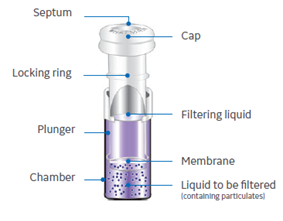Syringeless filter devices are an all-in-one filter solution for HPLC sample prep. Learn how these devices can simplify your workflow, help with consistent results, and improve lab efficiency.
If you’re not familiar with syringeless filtration devices like the MiniUniprep (MUP), they are designed for rapid high-performance liquid chromatography (HPLC) sample prep.
In this post, we answer some of the most common questions.
What are syringeless filter devices?
Syringeless filter devices from GE are particle filter devices made up of two major components, the plunger and the outer sample chamber. The plunger contains several parts: a filter membrane at one end, a chamber in the middle, and a cap with septum at the other end.
Our MUP filter devices have a range of membrane materials with different solvent resistances and pore sizes, so there is one to suit almost any sample.
The MUP replace syringe filters in pre-HPLC sample prep. Both devices are available in standard transparent or with an amber tint to protect light-sensitive samples, The MUP has a polypropylene vial.
How does a MUP device work?
Using a MUP device involves 3 simple steps (Fig 1):
- Load your sample into the outer chamber (bottom).
- Press the plunger to push sample through the membrane.
- Remove your clean filtered sample from the plunger chamber. It will be in a capped vial, ready for HPLC analysis.
Fig 1. Schematic of MUP filter device.
How can a MUP device help me get consistent results?
Filtering samples before HPLC analysis can improve results and protect your HPLC system from frit clogging, as we’ve discussed before.
When using a standard syringe filter, you’ll use a syringe, autosampler vial, and cap/septum for each sample. Not only does using multiple consumable products produce waste, but putting them together for every sample takes time and has a risk of leaks and spills.
Syringeless filter devices, like the MUP, reduce waste, save time, and provide an easy visual check that filtration has been performed. These all-in-one devices enable you to prep samples with just a couple of quick actions, and in one-third of the time. Keeping things simple and in one device helps you filter consistently across samples, and send fewer plastics for disposal.
MUP comes in either polypropylene or glass vials to ensure that you have a version that does not leach extractables that could interfere with analysis into your sample.
Can I do anything else to improve consistency?
Yes! Rather than filtering one sample at a time, or one in each hand, the MUP works with multi-compressors. These tools allow you to process up to eight samples at a time and are easier on your hands.
Using a multi-compressor makes sure all your samples are filtered with consistent pressure, removing any variation you might introduce manually over the course of a day. It is easier, quicker, and safer than filtering by hand.
Another thought that might improve sample-to-sample consistency is standardizing your device and membrane. The MUP is available with regenerated cellulose (RC) membranes. RC has broad compatibility for common HPLC solvents and low levels of extractables. This versatile membrane is suitable for filtering many sample types prior to HPLC analysis.
Will MUP devices work with my autosampler?
The MUP will work with most autosamplers. These filtration devices have the same dimensions as standard autosampler vials. They require only a small adjustment in autosampler needle height.
If you’re not certain whether an MUP device will work for you, we can help.
Try our Whatman filter selector to find out if you are using the most appropriate filtration solution for your samples. To discuss any challenges you are facing, please contact Cytiva's Scientific Support team.
